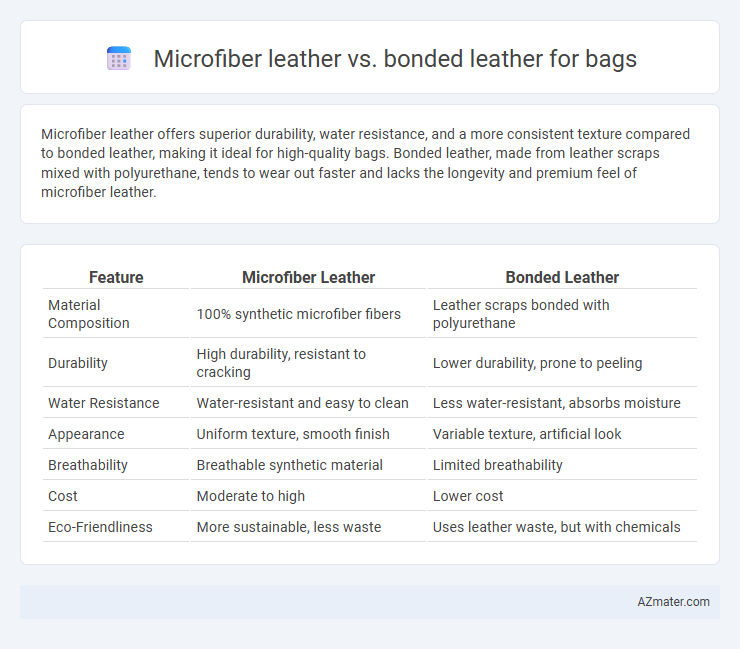Microfiber leather offers superior durability, water resistance, and a more consistent texture compared to bonded leather, making it ideal for high-quality bags. Bonded leather, made from leather scraps mixed with polyurethane, tends to wear out faster and lacks the longevity and premium feel of microfiber leather.
Table of Comparison
| Feature | Microfiber Leather | Bonded Leather |
|---|---|---|
| Material Composition | 100% synthetic microfiber fibers | Leather scraps bonded with polyurethane |
| Durability | High durability, resistant to cracking | Lower durability, prone to peeling |
| Water Resistance | Water-resistant and easy to clean | Less water-resistant, absorbs moisture |
| Appearance | Uniform texture, smooth finish | Variable texture, artificial look |
| Breathability | Breathable synthetic material | Limited breathability |
| Cost | Moderate to high | Lower cost |
| Eco-Friendliness | More sustainable, less waste | Uses leather waste, but with chemicals |
Introduction to Microfiber Leather and Bonded Leather
Microfiber leather is a synthetic material made from ultra-fine fibers that mimic the look and feel of genuine leather, offering enhanced durability, breathability, and resistance to water and stains. Bonded leather consists of shredded leather scraps bonded together with polyurethane or latex, providing an affordable alternative but with lower durability and less resistance to wear compared to microfiber leather. For bags, microfiber leather is often preferred due to its consistent quality, superior flexibility, and ease of maintenance.
Material Composition and Manufacturing Process
Microfiber leather, crafted from ultra-fine synthetic fibers tightly woven and coated with polyurethane, offers enhanced durability and breathability compared to bonded leather, which is produced by combining shredded genuine leather pieces with polyurethane or latex binders and then pressed into sheets. The manufacturing process of microfiber leather involves advanced textile technology ensuring consistent texture and resistance to wear, while bonded leather relies on recycling leather scraps, resulting in variability in surface quality and strength. Microfiber leather's composition allows for superior water resistance and easier maintenance, making it a preferred material for high-quality bags.
Durability and Longevity Comparison
Microfiber leather offers superior durability compared to bonded leather due to its synthetic fiber composition that resists cracking and peeling over time. Bonded leather, made from shredded leather scraps mixed with polyurethane, often deteriorates faster under stress and exposure to moisture. For bags requiring long-term use and wear resistance, microfiber leather provides enhanced longevity and maintains appearance better under daily wear conditions.
Appearance and Texture Differences
Microfiber leather offers a smooth, consistent texture that mimics genuine leather with a matte finish, providing a sleek and modern appearance ideal for high-end bags. Bonded leather, made from leather scraps bonded with polyurethane, tends to have a less uniform surface with slight imperfections and a glossier look, often resulting in a less natural feel. The tactile difference is notable, as microfiber leather feels soft and supple, while bonded leather may feel stiffer and less breathable.
Environmental Impact and Sustainability
Microfiber leather, made from polyurethane and polyester fibers, offers a more sustainable alternative due to its durability and lower environmental footprint compared to bonded leather, which is composed of leather scraps bonded with synthetic adhesives. Bonded leather often contains a higher percentage of chemicals and tends to degrade faster, leading to increased waste and less recyclability. Choosing microfiber leather for bags reduces reliance on animal products, minimizes landfill contributions, and supports eco-friendly manufacturing processes.
Water Resistance and Maintenance
Microfiber leather offers superior water resistance compared to bonded leather, making it ideal for bags exposed to moisture or wet conditions. Its synthetic fibers create a durable, non-porous surface that repels water more effectively, reducing the risk of damage and staining. Bonded leather, made from shredded leather scraps mixed with adhesives, tends to absorb moisture, requiring more frequent maintenance and careful conditioning to prevent cracking and deterioration.
Cost and Market Value Analysis
Microfiber leather offers a cost-effective and durable alternative to bonded leather for bags, with its synthetic fibers providing enhanced resistance to wear and moisture at a competitive price point. Bonded leather, composed of shredded leather scraps bonded with polyurethane, typically has a lower upfront cost but inferior durability, resulting in higher long-term replacement expenses and reduced market value. The growing demand for sustainable and high-performance materials in the fashion industry positions microfiber leather as a more valuable investment in terms of cost efficiency and resale potential.
Comfort and Weight Considerations
Microfiber leather offers superior comfort due to its breathable, soft texture and lightweight properties, making it ideal for everyday bags that require ease of carrying. Bonded leather tends to be heavier and less flexible, resulting in a stiffer feel that can reduce overall comfort during extended use. The advanced microfiber structure enhances durability while maintaining a lighter weight compared to the denser, composite materials found in bonded leather.
Applications in Bag Manufacturing
Microfiber leather offers superior durability, water resistance, and breathability compared to bonded leather, making it ideal for high-quality, long-lasting bags used in daily wear and outdoor activities. Bonded leather, composed of leather scraps bonded with polyurethane, is more affordable but less durable, often used in budget-friendly bags or decorative elements where cost is prioritized over longevity. Manufacturers prefer microfiber leather for premium bags due to its consistent texture and eco-friendliness, while bonded leather suits fashion bags targeting price-sensitive consumers.
Choosing the Right Material for Your Bag
Microfiber leather offers superior durability, water resistance, and a more realistic leather texture, making it ideal for long-lasting and stylish bags. Bonded leather, composed of leather scraps bonded with polyurethane, provides an affordable option but tends to wear out and peel faster over time. Choosing microfiber leather ensures better quality, ease of maintenance, and a premium look for your bag investment.

Infographic: Microfiber leather vs Bonded leather for Bag
 azmater.com
azmater.com